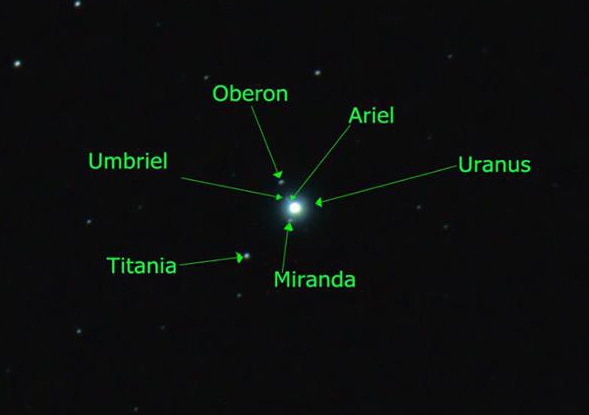Create a free profile to get unlimited access to exclusive videos, sweepstakes, and more!
Uranus Hangs a Moon. Five, in Fact.

Now, fair Hippolyta, our nuptial hour
Draws on apace; four happy days bring in
Another moonâ¦
â William Shakespeare, "A Midsummer Night's Dream", which has characters with the same names as the moons of Uranus
Uranus gets short shrift in our solar system. Really, the only time people hear about it is when itâs the butt of a joke (of which there is exactly one that is funny) âand for the record, I pronounce it âYER-uh-nissâ, which, if taken as an adjective, is to be honest not much better than how most people pronounce it.
But itâs actually a pretty cool planet. Although it wasnât officially discovered until 1781, itâs just barely within naked-eye visibility, and is an easy object in binoculars. Through even a small telescope it shows a definite disk, even from a distance of 3 billion kilometers (about 2 billion miles), and it has a distinctly greenish cast, due to methane in its upper atmosphereâ methane absorbs red light, letting only green and blue through.
Amazingly, several of its moons are also visible through a relatively small telescope, as astrophotographer Mike Carter proved just a few days ago!
The moons are labeled. These are the largest moons of Uranus, though theyâre still pretty faint. The dimmest, Miranda (donât tell River!), is about one ten-thousandth as bright as the dimmest star you can see with your naked eye. Still, Carter was able to get it in his shot, which consists of 100 15-second exposures added together, taken over the course of an hour on the evening of October 3rd/4th from his home in upstate New York.
Carter had another advantage: That was the night Uranus was at opposition. This is the term used by astronomers when a planet is directly opposite the Sun in the sky. That means the planet rises when the Sun sets, and is up all night. But it also means the planet is as close to the Earth as it will get all orbit, since the Sun, Earth, and the planet lie on a line, as seen in this mighty demonstration of my Photoshop skills:
If Uranus were anywhere else in its orbit, it would be farther from Earth. This means itâs the best time of the year to view the planet! Itâs up all night, itâs closest to Earth (2.8 billion km, or 1.8 billion miles), it appears biggest, and itâs also at its brightest. Universe Today has a guide to observing it, as does Sky and Telescope magazine.
A couple of days ago I went out with my 10x50 binoculars and spotted it easily, once I knew the star patterns (you can download planetarium software to show you; I like SkySafari). If you have a good pair of binocs, Iâd suggest giving Uranus a try. And if you spot it, think on this: The light entering your eyes left the planet nearly three hours ago! Astronomy lets you not just travel in space, but it takes you back in time, too. Quite a bargain for the price of simply going outside and looking up.


























